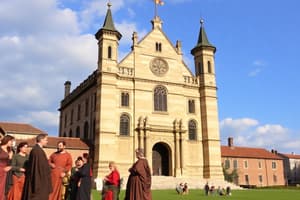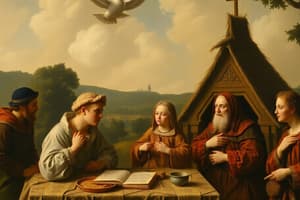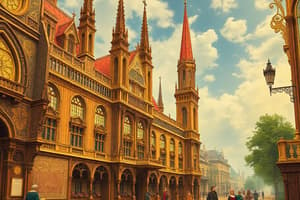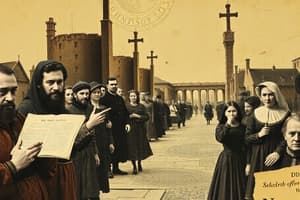Podcast
Questions and Answers
Which of the following best describes the significance of the printing press during the Renaissance?
Which of the following best describes the significance of the printing press during the Renaissance?
- It enabled the rapid dissemination of knowledge and ideas, contributing to intellectual and cultural changes. (correct)
- It primarily facilitated artistic expression through the creation of paintings and sculptures.
- It accelerated the spread of wealth through trade networks across Europe.
- It served as a tool for monarchs to exert greater control over their kingdoms.
Machiavelli's philosophical works, including The Prince, were published during his lifetime and were widely celebrated for their ethical principles.
Machiavelli's philosophical works, including The Prince, were published during his lifetime and were widely celebrated for their ethical principles.
False (B)
How did the concept of indulgences contribute to the rise of the Protestant Reformation?
How did the concept of indulgences contribute to the rise of the Protestant Reformation?
Selling indulgences
A document that would help absolve someone of their sins or be forgiven of their sins is called ___________.
A document that would help absolve someone of their sins or be forgiven of their sins is called ___________.
Match the individuals with their associated movements or contributions:
Match the individuals with their associated movements or contributions:
What was the primary goal of the Council of Trent?
What was the primary goal of the Council of Trent?
Which of these beliefs was central to Martin Luther's teachings that sparked the Protestant Reformation?
Which of these beliefs was central to Martin Luther's teachings that sparked the Protestant Reformation?
Explain how humanism influenced Renaissance art, providing an example.
Explain how humanism influenced Renaissance art, providing an example.
Which of the following best describes Petrarch's contribution to the Renaissance?
Which of the following best describes Petrarch's contribution to the Renaissance?
Machiavelli's 'The Prince' advocates for rulers to always act virtuously, regardless of the circumstances.
Machiavelli's 'The Prince' advocates for rulers to always act virtuously, regardless of the circumstances.
What is the name of Donatello's most famous sculpture?
What is the name of Donatello's most famous sculpture?
The _______________ was a Catholic Church tribunal that prosecuted people accused of heresy.
The _______________ was a Catholic Church tribunal that prosecuted people accused of heresy.
Match the following scientists with their major contributions:
Match the following scientists with their major contributions:
What was a significant difference between medieval and Renaissance science?
What was a significant difference between medieval and Renaissance science?
The scientific method solely relies on theoretical reasoning and abstract thought, without practical application.
The scientific method solely relies on theoretical reasoning and abstract thought, without practical application.
What invention was crucial in disseminating new ideas during the Scientific Revolution?
What invention was crucial in disseminating new ideas during the Scientific Revolution?
________________ proposed the heliocentric model of the solar system during the Renaissance.
________________ proposed the heliocentric model of the solar system during the Renaissance.
Which of these is the most accurate description of Humanism?
Which of these is the most accurate description of Humanism?
The Renaissance exclusively impacted Europe, with no cultural exchange occurring with other parts of the world.
The Renaissance exclusively impacted Europe, with no cultural exchange occurring with other parts of the world.
Name one of the key changes that resulted from the Protestant Reformation.
Name one of the key changes that resulted from the Protestant Reformation.
The Renaissance marked the transition from the ___________ Ages to the modern world.
The Renaissance marked the transition from the ___________ Ages to the modern world.
Which of the following best describes the major impact of the Scientific Revolution?
Which of the following best describes the major impact of the Scientific Revolution?
Match the following artists with their notable artworks:
Match the following artists with their notable artworks:
Flashcards
Renaissance
Renaissance
A period in European history (1300-1600) marked by a revival of classical art and learning.
Machiavelli
Machiavelli
A 16th-century Florentine philosopher known for his political ideas.
Leonardo da Vinci
Leonardo da Vinci
Italian artist, inventor, and scientist, embodying the 'Renaissance man'.
Michelangelo
Michelangelo
Signup and view all the flashcards
Protestant Reformation
Protestant Reformation
Signup and view all the flashcards
Indulgences
Indulgences
Signup and view all the flashcards
Humanism
Humanism
Signup and view all the flashcards
95 Theses
95 Theses
Signup and view all the flashcards
"The Prince"
"The Prince"
Signup and view all the flashcards
Petrarch
Petrarch
Signup and view all the flashcards
Scientific Method
Scientific Method
Signup and view all the flashcards
Raphael
Raphael
Signup and view all the flashcards
Donatello
Donatello
Signup and view all the flashcards
Roman Inquisition
Roman Inquisition
Signup and view all the flashcards
Scientific Revolution
Scientific Revolution
Signup and view all the flashcards
Printing Press Impact
Printing Press Impact
Signup and view all the flashcards
Isaac Newton
Isaac Newton
Signup and view all the flashcards
Galileo
Galileo
Signup and view all the flashcards
Lavoisier
Lavoisier
Signup and view all the flashcards
Renaissance Science
Renaissance Science
Signup and view all the flashcards
Study Notes
- The Renaissance was a period in European history from around 1300 to 1600
- The Renaissance was characterized by increased wealth through trade and the invention of the printing press
Machiavelli
- Niccolò Machiavelli was a 16th-century Florentine philosopher known for political ideas
- "The Prince" and "Discourses on Livy" were published after death.
Leonardo da Vinci
- Leonardo da Vinci (1452-1519) was a painter, inventor, scientist, and engineer
- Da Vinci is considered the quintessential Renaissance man.
Michelangelo
- Michelangelo was an Italian sculptor, painter, architect, and poet during the High Renaissance.
The Protestant Reformation
- A religious and political movement in the 16th century challenged the Catholic Church's authority
Indulgences
- Indulgences were documents that helped absolve someone of their sins
Martin Luther
- Martin Luther was a German theologian, professor, pastor, and church reformer.
Printing Press
- The printing press is a machine that transfers text and images from movable type to paper using ink
- The printing press was invented by Johannes Gutenberg.
English Reformation
- The English Reformation was a gradual process that began in the 16th century
- This separated the Church of England from the Catholic Church
John Calvin
- John Calvin was a French theologian, pastor, and reformer in Geneva during the Protestant Reformation.
King Henry VIII
- King Henry VIII established the Church of England and the Royal Navy.
Council of Trent
- The Council of Trent was a series of meetings held between 1545 and 1563.
- The purpose was to reform the Roman Catholic Church.
Counter Reformation
- The Counter Reformation as a period of Catholic reform in the 16th and 17th centuries.
- It was a response to the Protestant Reformation, aiming to make Christianity independent from the Catholic Church.
Calvinism
- Calvinism is a Protestant Christian theological tradition that began in the 16th century.
- It's based on the teachings of John Calvin, a Protestant reformer.
Lutheranism
- Lutheranism is a Christian denomination that originated in the 16th century during the Protestant Reformation.
- It's based on the teachings of Martin Luther.
Gutenberg
- Gutenberg designed and built the first known mechanized printing press in Europe.
95 Theses
- The 95 theses emphasized the Bible as the central religious authority.
- It stated that humans may reach salvation only by faith, sparking the Protestant Reformation.
Humanism
- Humanism focuses on the value and potential of humans.
- Art, e.g., Leonardo da Vinci focused on human beauty and emotions.
- Writers like Petrarch encouraged learning from the past.
The Prince
- "The Prince" is a book by Niccolò Machiavelli, written in 1513.
- It advises rulers on how to gain and keep power, even using tricks if needed.
Raphael
- Raphael was an Italian artist from the Renaissance period.
- Some famous pieces include the School of Athens and The Transfiguration.
Donatello
- Donatello was an Italian sculptor from the Renaissance, born in 1386.
- He created realistic sculptures, like his statue of David.
Petrarch
- Petrarch was an Italian poet and scholar from the 1300s.
- He was called the father of humanism because he loved studying ancient Roman and Greek.
- He wrote poems about love, especially Canzoniere, which was about a woman named Laura.
Roman Inquisition
- The Roman Inquisition was a Catholic Church tribunal.
- It prosecuted people accused of heresy or other crimes against Catholic doctrine.
Scientific Revolution
- A period of scientific discoveries (16th–18th century) used experiments and math.
Medieval vs. Renaissance Science
- Medieval science was based on old texts and beliefs.
- Renaissance science used observation and experiments.
Scientific Method
- The scientific method is a step-by-step way to test ideas using experiments and observations.
Galileo Galilei
- Galileo Galilei improved the telescope.
- He helped prove that the Earth moves around the Sun.
Isaac Newton
- Isaac Newton discovered gravity and the laws of motion.
Lavoisier
- Lavoisier helped create modern chemistry.
- He discovered how oxygen is important for burning.
Impact of the Printing Press on Europe
- The Scientific Revolution changed how people understood the world.
- The printing press made new ideas and discoveries widely available.
- The printing press and Scientific Revolution sparked the Enlightenment, promoting reason and knowledge.
Key Contributions and Effects of the Scientific Revolution
- Introduction of the scientific method
- Changed understanding of the universe (Copernicus's heliocentric idea)
- Discoveries in physics (Newton's laws)
- Challenged religious beliefs and promoted logical thinking.
- Fostered curiosity and set the stage for future scientific research and technological progress.
Humanism's Role in the Renaissance
- The Scientific Revolution emphasized observation and experimentation.
- It led to discoveries in astronomy, physics, and biology.
- Key developments included the heliocentric model, the telescope, and the laws of motion.
- The scientific method promoted a logical and evidence-based approach.
- Influenced philosophy and religion.
The Renaissance and Its Major Accomplishments
- The Renaissance means "rebirth" and was a cultural revival from the 14th to 16th centuries.
- There was renewed interest in the art and knowledge of ancient Greece and Rome.
- Significant changes occurred in art, literature, science, and philosophy.
- Humanism became a key idea, focusing on human potential and achievements.
- The printing press helped share new ideas quickly.
- Artists like Leonardo da Vinci, Michelangelo, and Raphael created incredible works.
- Scientists like Copernicus introduced new ideas, such as the heliocentric model.
Impact of the Protestant Reformation in Europe
- The Protestant Reformation broke the Catholic Church's hold on power
- It gave rise to various Protestant denominations.
- It sparked religious wars and conflicts.
- Resulted in changes in politics, culture, and economics.
- Led to greater individualism and a push for reforms.
Studying That Suits You
Use AI to generate personalized quizzes and flashcards to suit your learning preferences.




